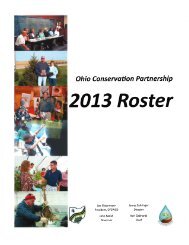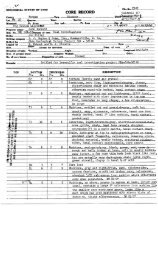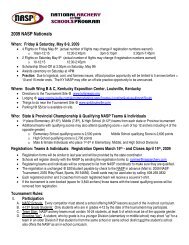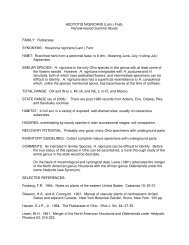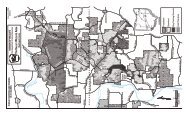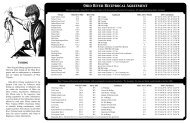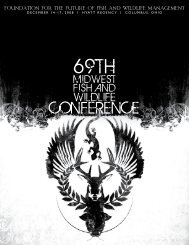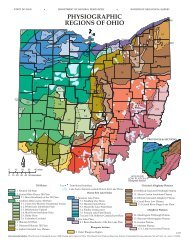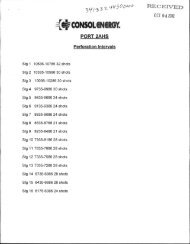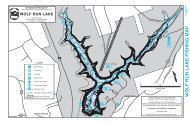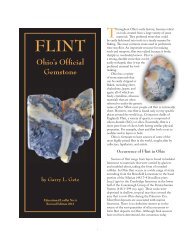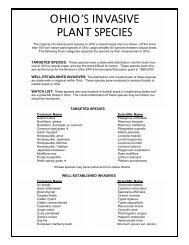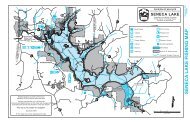Animals at Irwin Prairie - Ohio Department of Natural Resources
Animals at Irwin Prairie - Ohio Department of Natural Resources
Animals at Irwin Prairie - Ohio Department of Natural Resources
You also want an ePaper? Increase the reach of your titles
YUMPU automatically turns print PDFs into web optimized ePapers that Google loves.
<strong>Animals</strong> <strong>at</strong> <strong>Irwin</strong> <strong>Prairie</strong><br />
When we think <strong>of</strong> animals th<strong>at</strong> inhabit prairies, many <strong>of</strong> us envision gre<strong>at</strong> herds <strong>of</strong><br />
bison grazing across the short grass prairie <strong>of</strong> the Dakotas or Montana. In <strong>Ohio</strong><br />
we lack wild herds <strong>of</strong> bison and many <strong>of</strong> our prairies have succumbed to the plow<br />
<strong>of</strong> farmers. However, many remnant prairies still remain and <strong>Irwin</strong> <strong>Prairie</strong> is a<br />
fantastic one to observe the rel<strong>at</strong>ionship between animals and these wonderful<br />
landscapes.<br />
<strong>Irwin</strong> <strong>Prairie</strong> is unique in th<strong>at</strong> it is mostly comprised <strong>of</strong> wet prairie th<strong>at</strong> is<br />
domin<strong>at</strong>ed by twig rush, blue joint grass, and various other sedges. Just as the<br />
plants are unique, so are the animals th<strong>at</strong> live within them. Many <strong>of</strong> the species<br />
th<strong>at</strong> we are familiar with cannot survive in the harsh environment <strong>of</strong> <strong>Irwin</strong> <strong>Prairie</strong>.<br />
In the winter time, much <strong>of</strong> <strong>Irwin</strong> <strong>Prairie</strong> is covered in ice and snow. This is a<br />
gre<strong>at</strong> time to observe the raptors (birds <strong>of</strong> prey). The many seeds produced by<br />
the sedges and grasses provide ample food for mice, voles, and other small<br />
mammals which in turn become food for these skilled hunters. Red-tailed Hawks<br />
and Northern Harriers will fly over the prairie w<strong>at</strong>ching for the slightest movement<br />
<strong>of</strong> meadow voles and then pounce on them. Saw-whet Owls and Northern<br />
Shrikes prefer to sit in the pin oaks and wait till a meal presents itself.<br />
As spring roles around, the ice and snow melt and <strong>Irwin</strong> looks more like a marsh<br />
then a prairie. This is the best time to observe the animals. The open area <strong>of</strong> the<br />
prairie provides the needed space for the American Woodcock to perform its<br />
ritualistic m<strong>at</strong>ing dance. Ducks and geese are abundant in the deeper areas <strong>of</strong><br />
w<strong>at</strong>er as they dabble for left over seeds and aqu<strong>at</strong>ic invertebr<strong>at</strong>es. This food will<br />
provide them the needed nourishment for their long journey north to their m<strong>at</strong>ing<br />
grounds.<br />
Spring also provides us with the songs <strong>of</strong> the frogs and toads. In early spring we<br />
first hear chorus frogs and spring peepers followed l<strong>at</strong>er by the tree frogs. The<br />
wet areas provide them habit<strong>at</strong> to lay their eggs. On calm warm nights their<br />
combined songs can be deafening. Spring also allows us to see one <strong>of</strong> <strong>Ohio</strong>’s<br />
rarest turtles, the Spotted Turtle. This handsome little turtle only lives in wet<br />
prairies.<br />
As the days get longer and the summer sun shines, much <strong>of</strong> the w<strong>at</strong>er dries up <strong>at</strong><br />
<strong>Irwin</strong> <strong>Prairie</strong>. The frogs disperse and the Spotted Turtles burrow under ground<br />
and wait for the rain. Many birds have set up nests and are raising young. Bluewinged<br />
Warblers and Gre<strong>at</strong> Crested Flyc<strong>at</strong>chers can be seen c<strong>at</strong>ching insects in<br />
the prairie to take back to their young. <strong>Irwin</strong> <strong>Prairie</strong> provides these birds with<br />
swarms <strong>of</strong> insects and the open area for them to c<strong>at</strong>ch them.<br />
As the days get shorter and we<strong>at</strong>her cooler, many animals start to feed more for<br />
the winter hibern<strong>at</strong>ion or for their migr<strong>at</strong>ion south. Eastern Hog-nosed snakes
can be seen searching out toads and Black-billed Cuckoos start to raid the tent<br />
c<strong>at</strong>erpillars. Autumn is also fire season. Fire is the reason prairies have very few<br />
trees. And as the plants evolved to fire so has the animals. At the first sign <strong>of</strong> fire,<br />
the birds fly <strong>of</strong>f and mice head for their burrows. All <strong>of</strong> the inhabitants <strong>of</strong> prairies<br />
know how to survive fire. Fire is not only important to the prairie by elimin<strong>at</strong>ing<br />
trees it also provides nutrients to next years plant growth.<br />
As you can see different animals inhabit the different ecosystem th<strong>at</strong> is prairies. I<br />
hope th<strong>at</strong> you get out and enjoy these unique areas and its animals th<strong>at</strong> call them<br />
home.<br />
Steve Harvey<br />
Northwest District Preserve Manager<br />
<strong>Ohio</strong> <strong>Department</strong> <strong>of</strong> N<strong>at</strong>ural <strong>Resources</strong><br />
Division <strong>of</strong> N<strong>at</strong>ural Areas and Preserves



